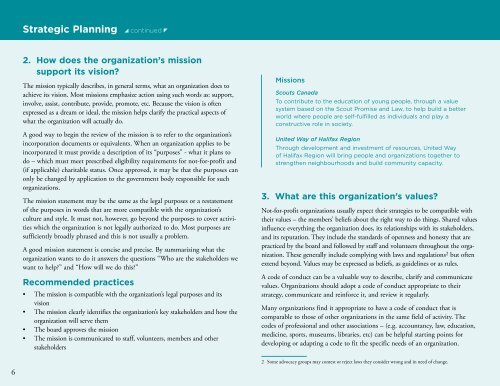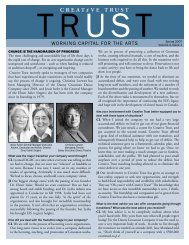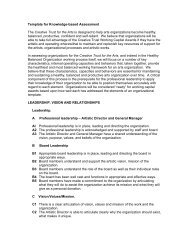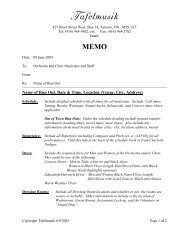20 Questions - Canadian Institute of Chartered Accountants
20 Questions - Canadian Institute of Chartered Accountants
20 Questions - Canadian Institute of Chartered Accountants
You also want an ePaper? Increase the reach of your titles
YUMPU automatically turns print PDFs into web optimized ePapers that Google loves.
Strategic Planning y continued z<br />
2. How does the organization’s mission<br />
support its vision?<br />
The mission typically describes, in general terms, what an organization does to<br />
achieve its vision. Most missions emphasize action using such words as: support,<br />
involve, assist, contribute, provide, promote, etc. Because the vision is <strong>of</strong>ten<br />
expressed as a dream or ideal, the mission helps clarify the practical aspects <strong>of</strong><br />
what the organization will actually do.<br />
A good way to begin the review <strong>of</strong> the mission is to refer to the organization’s<br />
incorporation documents or equivalents. When an organization applies to be<br />
incorporated it must provide a description <strong>of</strong> its “purposes” - what it plans to<br />
do – which must meet prescribed eligibility requirements for not-for-pr<strong>of</strong>it and<br />
(if applicable) charitable status. Once approved, it may be that the purposes can<br />
only be changed by application to the government body responsible for such<br />
organizations.<br />
The mission statement may be the same as the legal purposes or a restatement<br />
<strong>of</strong> the purposes in words that are more compatible with the organization’s<br />
culture and style. It must not, however, go beyond the purposes to cover activities<br />
which the organization is not legally authorized to do. Most purposes are<br />
sufficiently broadly phrased and this is not usually a problem.<br />
A good mission statement is concise and precise. By summarizing what the<br />
organization wants to do it answers the questions “Who are the stakeholders we<br />
want to help?” and “How will we do this?”<br />
Recommended practices<br />
• The mission is compatible with the organization’s legal purposes and its<br />
vision<br />
• The mission clearly identifies the organization’s key stakeholders and how the<br />
organization will serve them<br />
• The board approves the mission<br />
• The mission is communicated to staff, volunteers, members and other<br />
stakeholders<br />
Missions<br />
Scouts Canada<br />
To contribute to the education <strong>of</strong> young people, through a value<br />
system based on the Scout Promise and Law, to help build a better<br />
world where people are self-fulfilled as individuals and play a<br />
constructive role in society.<br />
United Way <strong>of</strong> Halifax Region<br />
Through development and investment <strong>of</strong> resources, United Way<br />
<strong>of</strong> Halifax Region will bring people and organizations together to<br />
strengthen neighbourhoods and build community capacity.<br />
3. What are this organization’s values?<br />
Not-for-pr<strong>of</strong>it organizations usually expect their strategies to be compatible with<br />
their values – the members’ beliefs about the right way to do things. Shared values<br />
influence everything the organization does, its relationships with its stakeholders,<br />
and its reputation. They include the standards <strong>of</strong> openness and honesty that are<br />
practiced by the board and followed by staff and volunteers throughout the organization.<br />
These generally include complying with laws and regulations 2 but <strong>of</strong>ten<br />
extend beyond. Values may be expressed as beliefs, as guidelines or as rules.<br />
A code <strong>of</strong> conduct can be a valuable way to describe, clarify and communicate<br />
values. Organizations should adopt a code <strong>of</strong> conduct appropriate to their<br />
strategy, communicate and reinforce it, and review it regularly.<br />
Many organizations find it appropriate to have a code <strong>of</strong> conduct that is<br />
comparable to those <strong>of</strong> other organizations in the same field <strong>of</strong> activity. The<br />
codes <strong>of</strong> pr<strong>of</strong>essional and other associations – (e.g. accountancy, law, education,<br />
medicine, sports, museums, libraries, etc) can be helpful starting points for<br />
developing or adapting a code to fit the specific needs <strong>of</strong> an organization.<br />
6<br />
2 Some advocacy groups may contest or reject laws they consider wrong and in need <strong>of</strong> change.












